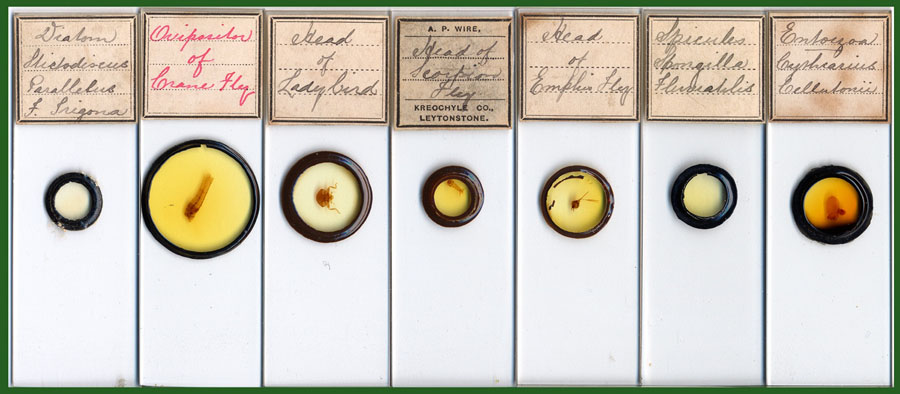
Alfred P. Wire (1839-1914), Victorian/Edwardian microscopist, entrepreneur, photographer and educator
by Brian Stevenson, Lexington, Kentucky, USA
This past summer, I purchased a box of 144 old microscope slides, most of which had labels that identified the specimens, but not the slides’ makers. Among the slides I acquired was a group of about 30 slides that had the same handwriting. Fortunately, a hunt through other slides in my collection turned up a previous acquisition that had the specimen name written in the exact same handwriting, and with additional information identifying the maker as A.P. Wire (Figure 1). Wire was mentioned briefly in Brian Bracegirdle’s Microscopical Mounts and Mounters: “Kreochyle Co, Leytonstone, put up botanical preparations in the 1880s/90s.” Two examples of his work were illustrated in that resource (plate 39, slides E and F), although the maker had written both labels in a plain hand, rather than in the cursive he used for the examples shown below in Figure 1.

Figure 1. Examples of Alfred Wire’s prepared microscope slides. The center slide contains a label with Wire’s name and location. The other slides bear the same handwriting. Note his use of both black and red ink for labeling, suggesting that these slides came from at least two separate lots. See Fig. 2 for magnified views.
As is evident from the slides shown in Figure 1, A.P. Wire prepared a wide variety of subjects. Magnified views of two of those slides are shown in Figure 2. The fly head is fairly well laid out, although not perfect. The diatom slide holds a single specimen, indicating that Wire was capable of sorting and mounting individual diatoms. Why none of the recently purchased slides were marked with Wire’s name remains a mystery. One possibility is that they were initially purchased in bulk, and that the maker’s name was attached to the original container. Alternatively, they may have been sold through a distributor who did not want the maker’s name to be attached. I have since seen several additional slides with A.P. Wire’s handwriting for sale on the internet. Those, plus the large number of slides I bought, suggest that Wire was a sizeable producer of microscope slides. But who was A.P. Wire? And what/where is Kreochyle Co? After a bit of research, I discovered that Mr. Wire was quite a remarkable person who excelled at a large number of activities.
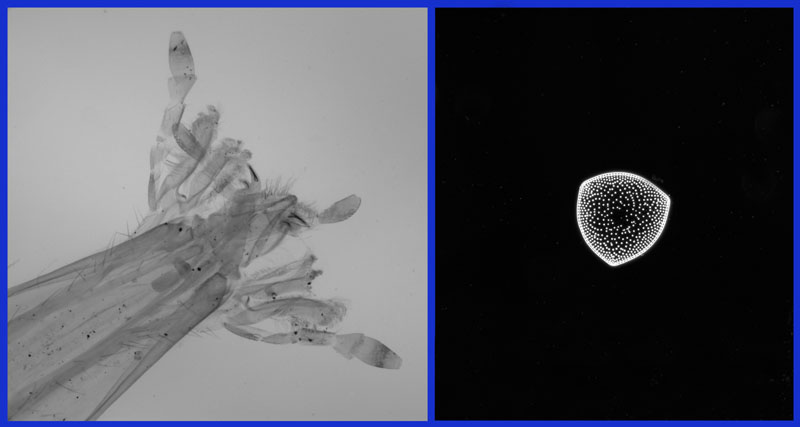
Figure 2. Photographs of two of the specimens on the slides shown in Fig. 1. Left, “head of scorpion fly”, using a 4x objective lens and brightfield illumination. Right, “diatom – Stictodiscus parallelus”, using a 10x objective lens and darkfield illumination. Photographed using an Olympus BX51 microscope and a Retiga 2000R Fast 1394 digital camera with QCapture Pro software.
Alfred Philip Wire was born during the autumn of 1839, in Colchester, Essex. He was the fourth of at least seven children of William and Mary Wire. William was a watchmaker and a post carrier. In 1856, Alfred became a pupil teacher in St. Mary’s National School, Colchester. He later received a Queen’s Scholarship for training in education at the National Societies Training College in Battersea, Surrey, and earned a first class certificate in 1861. He married Susan Horth during the autumn of 1863, with whom he had at least eight children over the next 20 years. The 1871 census records Wire as a teacher at All Saints School, Newmarket, Cambridgeshire. From 1877 until his death at age 74 in 1914, he was Headmaster of Harrow Green School, Leytonstone. In 1907, The Practical Teacher published an autobiography of Wire’s teaching career and his reflections on changes in education over the years.
Alfred Wire was elected a member of the Essex Field Club in February, 1882. The Club’s Transactions notes numerous donations of books, pamphlets and periodicals by Wire during that and subsequent years. He was also active in making presentations to the Club, such as “species of fossil shells from the Woolrich beds at Leyton” and “a specimen of the curious shell-marl from Copford, Essex”. He was also noted as providing a microscope(s) for Club meetings. Wire served as the Club’s librarian from at least 1891 onward. He and his wife each contributed money to help the Club publish a book entitled The Birds of Essex, in 1890.
The earliest record I found of Alfred Wire’s interest in microscopy is an exchange request in an 1884 issue of Hardwicke's Science-Gossip, in which he advertised to provide a polariscope slide of sulfur crystals and other specimens (Figure 3A). In 1885, Wire’s ads in that magazine implied that numerous types of slides were available for exchange or sale (Figure 3B).

Figure 3. Advertisements for sale or exchange of slides by Alfred Wire. (A) An exchange request from Hardwicke’s Science-Gossip, 1884. (B) Exchange/sale ad from the same source, 1885.
The two examples of Alfred Wire’s slide preparations shown in Bracegirdle’s Microscopical Mounts and Mounters are both are of oak stems, dated 1885 and 1886. On a related note, A. P. Wire was recorded as having displayed specimens of “oaks in various stages of growth” at the June 17, 1887 meeting of the Western Microscopical Club. However, the examples in Microscopical Mounts and Mounters were mounted in Canada balsam (note “CB” written on the labels), while the specimens he exhibited in 1887 were “prepared in boroglyceride”.
Wire provided details on the use of boroglyceride as a mounting medium in Hardwicke's Science-Gossip, 1885, pages 139-140 (figure 4). The Journal of the Royal Microscopical Society printed an abbreviated version of his Science-Gossip article later that year. The use of boroglyceride as a mounting medium appears to have caught on with other people. In 1886, E.B.L. Brayley wrote in Science-Gossip that Hydrachnea “may be splendidly preserved by putting them living into a cell containing a saturated solution of boro-glyceride, and sealing the mount down. The animal will probably live in this for a day or two, and then will be perfectly preserved in form and colour.” This was particularly crafty advertising by Wire, in that he did not mention that he was an owner of the company that produced boroglyceride!
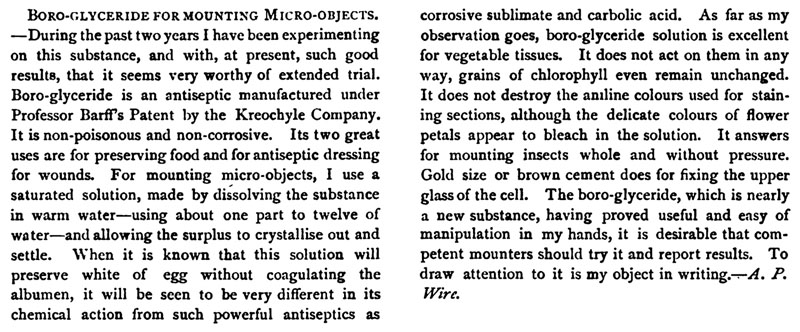
Figure 4. Instructions by Alfred Wire on the use of boroglyceride as a mounting medium, 1885. Note that he never mentions that he is part owner of the Kreochyle Company.
From records I have identified, Alfred Wire formed a partnership with Professor Frederick Settle Barff at some time prior to 1883. According to Professor Barff’s 1886 obituary in the Journal of the Chemical Society, Barff had received a medal from that society for his work on boro-glyceride, a compound of boric acid and glycerin that was generally used as an antiseptic and food preservative. Barff was also famous for development of the Bower-Barff process for protecting iron from rust. Although it is unclear who came up with the idea, Wire and Barff produced and sold a food supplement named “Kreochyle”, which was a meat extract that contained boroglyceride. Their Kreochyle Company sold both Kreochyle meat product and boroglyceride (Figure 5). At the 1884 International Health Exhibition, the Kreochyle Company exhibited their “liquid meat” as “a food for invalids and infants containing, in addition to other meat extractives, the whole of the soluble albumen of the meat in an uncoagulated and easily digestible form.”
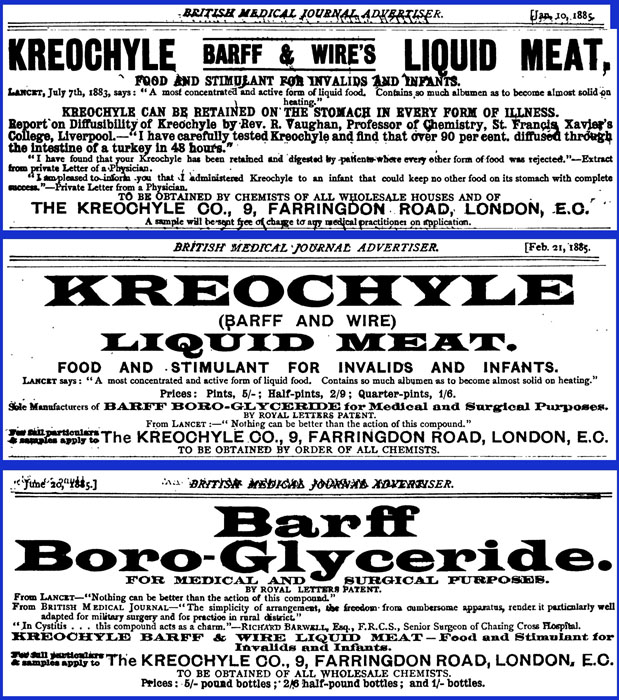
Figure 5. Advertisements from Alfred Wire’s Kreochyle Company for Kreochyle food and boroglyceride. Excerpted from the British Medical Journal, 1885.
Following Barff’s death in 1886, several publications speculated that the secret of “his” Kreochyle would be lost forever. This spurred Alfred Wire to write a letter to the English Mechanic and World of Science that September, stating “I was interested in the paragraph in “Scientific News” last week referring to my respected friend the late Professor Barff; but will you allow me to correct an error you have inadvertently made? Kreochyle was not invented by Professor Barff, neither has the secret died with him. I am the sole inventor of Kreochyle, and Professor Barff found the money to perfect it; he became joint patentee with me, and then associated to form the Kreochyle Company, which still makes both Kreochyle and boroglyceride.” Advertisements for Kreochyle can be found in numerous publications over the following decades, so it appears that Wire kept the company going for quite some time. He was listed as a member of the Society of Chemical Industry during 1892-93, and presumably was a member for other years.
Alfred Wire also achieved note as a photographer, especially of scenery and people around Essex. The Vestry House Museum in Waltham Forest has a sizeable collection of Wire’s photographs. Many can be seen on the Museum’s web site, which also includes an 1892 photograph of Wire (see also Figure 6 of this article). A photo by Wire can also be found on the current web site of the Essex Field Club. A collection of Wire’s photos was published in 1995 as Images of Essex,1880-1914: Photographs by Alfred Wire.
In 1894, Wire and G. Day published Knowledge Through the Eye; or, How to Illustrate Science and Other Lectures by Means of the Optical Lantern, With a New Method of Preparing Lantern Slides. His expertise in producing magic lantern slides was undoubtedly linked to his experiences as a microscope slide maker and photographer. On a related note, the Essex Naturalist noted a March 21, 1891 exhibit in which “some photographs were then thrown upon the screen by Mr. Wire, consisting principally of views taken by himself during the last year's field meetings, views of the Higham Park from drawings by Mr. H. A. Cole, and some copies of old prints of Essex localities, &c.”
Wire wrote several other books, short stories and essays, including the 1904 book Two Legends of Colchester”, illustrated by W. Gurney Benham, and the 1900 story The Curse of the Crooked Cross: a Legend of St. Botolph’s Priory, Colchester.
As if that wasn’t enough, Alfred Wire was also an archeologist of some note. In his 1897 book The Ancient Stone Implements, Weapons and Ornaments of Great Britain, John Evans reported that “from gravel at Grove Green Lane, Leyton, some good pointed implements have been obtained by Mr. A.P. Wire. One of them is 6 inches long.” In 1903, Wire wrote for the Essex Review on “The Earliest Human Likeness”, a shell “which has engraved on it the figure of a human face”. A photograph by Wire accompanied an 1897 article on the engraved shell which appeared in The Strand magazine. In 1905, Wire donated “a perforated stone hammer head” to the Colchester Museum.
Alfred Philip Wire was highly productive in many fields. He appears to have been a significant supplier of prepared microscope slides during the late 1800s, and possibly into the early 1900s. He was relatively competent in his ability to mount a wide range of specimens. One goal of this article is to help other people identify any A.P. Wire slides they may have in their collections. I also hope that other collectors who have identified the makers of unlabelled slides will make that information widely known.
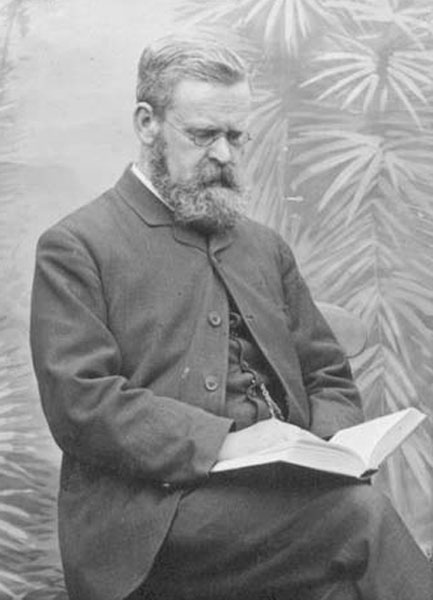
Figure 6. Photograph of Alfred P. Wire, 1892. Courtesy of the London Borough of Waltham Forest, Vestry House Museum.
All comments to the author Brian Stevenson are welcomed.
Acknowledgements
Many thanks to the Vestry House Museum for permission to reproduce the photograph of Alfred Wire.
Resources
Brian Bracegirdle, Microscopical Mounts and Mounters, 1998, Seacourt Press, Cowley, Oxford
E. B. L. Brayley, “The Natural Preservation of Rotifera and Other Pond Organisms”, Hardwicke’s Science-Gossip, 1886, pages 149-150, (http://www.archive.org/stream/hardwickesscienc22cook/hardwickesscienc22cook_djvu.txt)
Miller Christy, The Birds of Essex, 1890, Essex Field Club Special Memoirs, vol II (http://books.google.com/books?hl=en&id=GxwXAAAAYAAJ)
John Evans, The ancient stone implements, weapons and ornaments of Great Britain: weapons, and ornaments, of Great Britain, 1897, page 603 (http://books.google.com/books?id=VmETAAAAYAAJ&pg=PA603&dq=%22Mr+A+P+wire%22)
Colm Kerrigan, Teachers and Football, Schoolboy Association Football in England, 1885-1915 (http://books.google.com/books?id=yX_ag6rpz0QC&pg=PP13&dq=%22alfred+wire%22+master+school#PPA1,M1)
Alfred Wire, 1900, “The Curse of the Crooked Cross: a Legend of St. Botolph’s Priory, Colchester”, Essex Review, vol IX, page 231 (http://books.google.com/books?id=WToNAAAAIAAJ&pg=PA231&dq=%22alfred+wire%22+witch&lr=#PPA232,M1)
Alfred Wire, 1903, “The Earliest Human Likeness” Essex Review, page 174 (http://books.google.com/books?id=2joNAAAAIAAJ&pg=PA174&dq=%22+AP+Wire%22+microscope)
England census, birth, marriage and death records, accessed through ancestry.co.uk
The Antiquary, 1905, page 125 (http://books.google.com/books?id=ecsCAAAAYAAJ&pg=PA125&dq=%22Mr+A+P+wire%22#PPA121,M1)
The British Homoeopathic Review, 1885, vol. 29 (http://books.google.com/books?id=KEdYAAAAMAAJ&pg=PA775&dq=kreochyle+wire#PPA510,M1)
British Medical Journal, 1885, vol.1 advertisements
(http://books.google.com/books?id=c1ABAAAAYAAJ&pg=PT838&dq=kreochyle+wire)
The English Mechanic and World of Science, vol. 44, 1886, Sept. 10, page 38 (http://books.google.com/books?id=HJcAAAAAMAAJ&pg=PA38&dq=kreochyle+wire)
The English Mechanic and World of Science, 1887, page 364 (http://books.google.com/books?id=6ncAAAAAMAAJ&pg=PA364&dq=%22Mr+A+P+wire%22)
The Essex Review, 1907, page 212 : (http://books.google.com/books?id=s0MNAAAAIAAJ&pg=PA212&dq=%22Mr+A+P+wire%22&lr)
The Essex Naturalist, 1887, pages 6, 166, 219 and 257 (http://books.google.com/books?id=E54UAAAAYAAJ)
The Essex Naturalist, 1891, pages 31 130 and 136 (http://www.archive.org/stream/essexnaturalistb00esse/essexnaturalistb00esse_djvu.txt)
The Essex Naturalist, 1904, ads for “Two Legends of Colchester”, pages 49, 96, etc. (http://books.google.com/books?id=R6EUAAAAYAAJ)
Hardwicke's Science-Gossip, 1884, pages 144 and 192 (http://www.archive.org/stream/hardwickesscienc20cook)
Hardwicke's Science-Gossip, 1885, pages 139-140 and 144, (http://books.google.com/books?id=CCMWAAAAYAAJ&pg=RA1-PA139&dq=kreochyle+wire)
International Health Exhibition, Official Catalogue, 2nd edition, 1884, page 20 (http://books.google.com/books?id=vwgTAAAAIAAJ)
Journal of the Chemical Society, 1886, Obituary for FS Barff, pages 471-472 (http://books.google.com/books?id=1uo4AAAAMAAJ&pg=RA1-PA471&dq=%22chemical+society%22+barff)
Journal of the Royal Microscopical Society, 1885
Journal of the Society of Chemical Industry, List of members, 1892-93 (http://books.google.com/books?id=EOFYAAAAMAAJ&pg=RA1-PR25&dq=wire+%22seaton+villas%22#PRA1-PR2,M1)
Nature, 1894, Review of “Knowledge through the Eye”, page 433 (http://books.google.com/books?id=GDpsUDz26QcC&pg=PA433&dq=%22Mr+A+P+wire%22)
Parliamentary Papers, 1859, report of school progress (http://books.google.com/books?id=EdcSAAAAYAAJ&pg=PA62&dq=%22alfred+wire%22+master+school)
The Strand Magazine, 1897, page 239 (http://books.google.com/books?id=8ukvAAAAMAAJ&pg=RA1-PA239&dq=%22+AP+Wire%22+microscope)
Transactions of the Essex Field Club, 1882, pages xxv, xxiv, iii, xii, li, and lxxx (http://books.google.com/books?id=63gFAAAAQAAJ&pg=RA2-PR25&dq=%22Mr+A+P+wire%22)
Essex Field Club web site (http://www.essexfieldclub.org.uk/portal/p/Geology+Site+Account/s/St.%20Chad%27s%20Well)
Waltham Forest web site: A.P. Wire (http://www.walthamforest.gov.uk/index/leisure/museums-galleries/vestry-house-museum/photographic-archive/hoe-street-walthamstow/a-p-wire.htm)
Images of Essex,1880-1914: Photographs by Alfred Wire
Stroud, Gloucestershire, United Kingdom, Sutton Publishing Ltd. 1995. (ISBN: 0750910046)
Microscopy UK Front
Page
Micscape
Magazine
Article
Library
Please report any Web problems or offer general comments to the Micscape Editor .
Micscape is the on-line monthly magazine of the Microscopy UK website at Microscopy-UK .